
But what can lasers really do for your skin? Are any of the latest lasers really the greatest? We'll help you sort out the hope from the hype with our primer on laser skin resurfacing, also called laser rejuvenation, laser skin tightening or laser surgery.
Lasers can treat aging and sun-damaged skin, but that's not all — not by a long shot (or zap, as the case may be). Other applications include:
- Removal of birthmarks and vascular lesions (such as hemangiomas and port wine stains)
- Moles and warts
- Tattoos
- Unwanted body hair
- Skin diseases such as vitiligo and psoriasis. Vitiligo is marked by white patches caused by the destruction of melanocytes, the cells that give skin its color. Psoriasis is a chronic skin problem that occurs when skin cells grow too quickly, resulting in thick patches of skin.
- Acne
- Scars
The word "laser" is actually an acronym for light amplification by stimulated emission of radiation. Lasers create intense beams of visible, infrared or ultraviolet light. When laser light is absorbed by your skin it's converted to heat, which can result in the burning or coagulation of the targeted tissue.
Different lasers emit different colors and wavelengths. These colors of laser energy are absorbed by different facets of the skin or tissue, which is why certain lasers are recommended to treat certain conditions or skin types over others.
Some lasers are pulsed, which means that the beam is turned on and off in short pulses. Others are continuous wave, which means they emit a continuous beam of laser light.
To understand how and where lasers affect your skin, you must understand the layers and structure of your skin. The skin has three basic layers: the epidermis, dermis, and subcutis. The epidermis is the outermost layer of the skin. It is comprised of the stratum corneum (mostly dead skin cells called keratinocytes), live keratinocytes and the basal layer (which makes the keratinocytes). The epidermis also contains the melanocytes, or pigment-containing skin cells that give our skin its color. The dermis, or middle layer, is mostly made up of skin cells, hair follicles and sweat glands that are held together by collagen. Collagen is the main structural protein found in our skin and is produced by skin cells called fibroblasts.
source : facialplasticsurgery